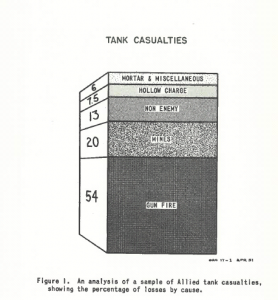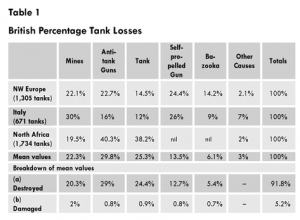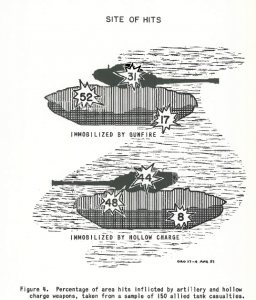Over 6000 American tanks were lost in the European Theater of Operation. Over 3000 British tanks were lost in Northern Europe and hundreds of Canadian and French tanks were lost after the D Day invasions until VE Day. Now what knocked out all these tanks. Almost naturally we think that German Panzers account for at least a majority of these losses, but that isn’t the case. Real combat isn’t like WoT, there are many other things besides tanks that fight and kill tanks.
An American studies states that based off a sample of 12000+ Allied tank casualties from all theaters of WWII 54% of casualties were the result of gunfire. “Gunfire” includes tanks of course, but also includes AT Guns, StuGs, other SPGs, and artillery pieces. The incompleteness of records led to the report to only reference gunfire instead of breaking it down further into different percentages. The second biggest percent is AT mines at 20%. Noncombat reasons(being stuck in the mud, mechanical breakdown, etc.) was the 3rd highest cause at 13%. The figure of 13% is, in all likelihood, too low. The US and British Armies were more concerned with weapon damage, the Canadian Army and the USMC recorded “more accurate” percentages of 25% to 40% of casualties attributed to noncombat reasons. Hollow Charge weapons like the panzerfaust were the 4th highest cause at 7.5 %. The remaining 6.5% was everything from mortars to aircraft to satchel charges.
*A tank casualty/loss is a tank that is unavailable for movement in a battle area. More than half of all losses were repairable.
Gunfire in all its forms causes the majority of Allied tank casualties. A British Report, broke down a sample of British tank casualties down further. Splitting up the gunfire into AT Guns, Tanks, SPGs, along with Mines and Bazookas(Hollow Charges).
The British experience in NW Europe(aka ETO) is analogous and comparable to the US’s. It can be assumed that these figures for NW Europe/ETO would be similar. The American Study’s samples show the British had more causalities, percentage wise, due to gunfire than American forces. In 1944 for example, the study showed that 50.9% of Amerian tanks sampled were lost due to gunfire compared to 59.2% of the British.
It seems that AT Guns and StuGs were much more responsible for tank losses than the Panzers. What is truly surprising is just how high the figure is for SPGs. This British study suggests that nearly 1/4 of Allied Tank losses in the ETO were caused by StuGs and other German SPGs. German’s Panzers only seemed to be the cause of 14.5% of tank losses. Large armored battles(Normandy, The Bulge, Push into Germany) did see spikes in casualties as seen below. 14.5% is still a noticeable percent, even if it is overshadowed by ~47% of SPGs and AT Guns combined. A British Study done of tank combat in Normandy shows that the Pz IV was the most common tank in the ETO and it can be fair to assume that it caused the majority of that 14.5%.
In the ETO gunfire was mainly from “medium” caliber guns, the 8.8 cm and the 7.5 cm guns which accounted for ~86% of losses due to gunfire. The study states that 50% of the gunfire was attributed to the 8.8 cm guns and 36% to the 7.5 cm guns. It is noteworthy to add that this is likely skewed because of the habit among troops to refer to most medium caliber guns as 8.8 cm guns. A report from US 1st Army, for example, has the figures for 55% for the 7.5 cm and 30% for the 8.8 cm. Smaller caliber guns accounted for 6%, large calibers accounted for a whopping 3%.
Gunfire casualties in the ETO were knocked out of action at an average of ~800 yards. German gunners didn’t seem to aim for any particular part of the tanks, the study’s authors suggest that the Germans fired at the first part of the vehicle they saw. 60% of gunfire hits were recorded to be hit from the side. 37% of hits were from the front and 3% were done from the rear. Distribution(turret/hull/suspension) of gunfire on tanks can be seen below along with distribution of tanks KO’ed by hollow charges.
Gunfire penetrations usually resulted in a single crew death and a single crewman wounded. Crews were rarely all killed, even if a tank burned. American Wet Storage also diminished the chances of burning in general. M4s with wet storage burned as little as 5 to 10%. British and Canadian burn rates were 80+%. American tanks in Italy, without wet storage also saw an 80% burn rate. That goes to show the “magic” of proper ammo storage. Distribution of casualties among crewmen is roughly even,unlike WoT’s radiomen…Light tanks had higher casualty rates(~65% per position) over their medium cousins(~50%). Please don’t confuse casualty with death.
Panzerfausts and Panzershrecks were responsible for around 13% of tank losses in ETO almost as much as Pz IVs, Panthers, and Tigers combined. Hollow charge weapons in the ETO usually dealt losses at a range of 50 yards(46 m). A report from the 736th Tank Battalion noted that Hollow Charge weapons were used in German Towns and roadblocks and were used to disable tanks, rarely actually destroying the vehicle. When the tankers existed the immobile tank they were gun downed by enemy small arms, American tankers didn’t seem to have adequate training in this regard. 51% of hollow charge rounds hit from the side, 31% from the front, 9.5 % from the rear, and 8.5% from above.
AT Mines were a constant threat for tanks and tankers in all theaters of war. In the ETO mines seemed to be the cause of 20-22% of tank losses. AT Mines rarely wounded or killed tankers. AT Mines were a very cost effective way to fight advancing tanks in WWII. In the Aachen Eschweiler mine fields it would take just ~221 mines(~$3700 total) to destroy a tank(~$200000). This rate was was higher in North Africa and Italy.
Data pulled from the French about the 1940 Battle of France seem to show that gunfire was the overwhelming cause of 95.4% of 1749 French tank losses. Mines took out 2.6% of French tanks while the Luftwaffe took out 2%. In 1944 and ’45 the French armored forces lost 549 tanks. Gunfire was the primary cause for French losses that couldn’t be repaired.
In conclusion it can be said that Germany’s most effective AT weapons were not the mythical Panthers and Tigers, but more humble weapons. The Panthers and Tigers combined likely only destroyed a few hundred Allied Tanks in the ETO, the Pz IV likely knocked out more just due to its numbers and availability. The StuG’s ability in AT combat is very impressive according to these studies, personally I’d give the “best tank of WWII” honors to the Pz III/StuG III. 7.5 cm and 8.8 cm AT guns showed their worth on the battlefield as well. The 7.5 cm gun, not the “dreaded” 8.8 cm, was in all likelihood the most effective German AT gun. Hollow Charges were an inexpensive and effective way for the Germans to combat Allied tanks along with AT Mines.
The trend seems to be that the more “humble” German weapons were more efficient than the famed 8.8 cms, the Luftwaffe(huehue), Tigers, and Panthers at knocking out Allied tanks. The location of hits on Allied vehicles show that side armor and ,to a lesser extent, frontal armor were not thick enough to stop the majority of Germany’s AT weapons. Lighter armored light tanks like the Stuarts were more dangerous to be crewed than mediums like the M4 and Cromwell. In British, Canadian, and non-ETO US vehicles, ammo storage was done poorly in comparison to the wet storage techniques of American tanks in NW Europe. Wet storage would have decreased crew casualties while likely increasing the rate of tanks that would be repairable in those units.
Sources:
The Comparative Performance of German Anti-Tank Weapons During World War II by H. G. Gee
ORO Survey of Allied Tank Casualties of WWII by Coox and Naisawald
Armored Thunderbolt by S. Zaloga
A Survey of Tank Warfare in Europe from D-Day to 12 August 1944 by H. G. Gee






Hello Priory,
Awesome post. Very informative and pretty fun read as well. I found the part about wet stowage in Shermans to be the most interesting. I was wondering, by the time the US started using the wet stowage containers for the rounds, how quickly did they convert the majority of the arsenal to use those containers? Were the wet containers even adopted universally for the M4s?
The M4s that landed in the initial fighting in Normandy were not equipped with wet storage. They did have applique armor to help cover the ammo racks. The M4A3s that were deployed to Europe after D Day featured it. The composition of wet storage increased as the war went along. I don’t know the exact figures unfortunately. Post-war the US kept the M4A3E8, the post-war E8s did away with the “wet” part of the ammo storage. It was determined that the placement of the ammunition at the bottom of the hull was reason of why wet storage had been so effective, not so much the wet part itself.
Seems pretty relevant to this topic, so I’ll just leave it here… https://www.youtube.com/watch?v=CtsCVEqfNiE
Pimpin’
So BASICALLY you are saying to me StuG is awesome.
I knew that allready, i have like 2k games in it!
i prefer Tig.
I prefer VK30.02D.
PANTHEEEEER
+1
The 8,8cm Paks were certainly far to heavy and therefore immobile to be effectively employed as anti tank guns, given that the Wehrmacht considered even the Pak 40 as to cumbersome and heavy, hence the Waffenträger and high-pressure/low-pressure gun programs.
Not to mention tall . Very hard to hide as compared to the 38.
btw how much pen did Pak 38 have in real life with standard ammo?
Soviets had it at 74 mm @ vertical. Not enough to get through the M4′s frontal armor(~90 mm LOS) in most instances.
Chamberlain and Doyle have it listed with 69mm at 100 meters on a 30 degrees from vertical plate with Panzergranate 39.
With Panzergranate 40 it’s 130mm.
Exactly the same values WG uses for the KwK 39.
BTW, 7,5cm KwK 42 L/70 is listed with 138mm / 194mm, 8,8cm KwK 36 L/56with 120mm / 171mm, 8,8cm KwK 43 L/71 with 203mm / 237mm, 12,8cm PaK 44 L/55 with 187mm (Panzergranate 43).
I guess most people know this thread already or similar threads but for those who dont , take a look here and you find houndreds of great world war 2 photos :
http://forums.gamesquad.com/showthread.php?104031-WW2-Photos/page43
Did this report take into consideration the proportion of PzIV tanks fielded compared the the number of available StuGs?
The report on British fighting in Normandy had 240 StuGs and 241 Pz IVs in the area.
Although the Pz4 obviously was fielded more than the heavier tanks, could the large ratio of Pz4s over most other tanks also be attributed to the tendency to name most German tanks as Pz4s by default by Allied crews?
Hard to judge, but I would have assumed StuGs outnumbered any other tank model in the 44-45 WTO.
Most German tanks were referred to as Tigers by Allied crews.
StuGs were about 1:1 with Pz IVs in Normandy. StuGs were not counted as tanks either.
In 1943 about 3000 StuG III L/43 and L/48 were built. The number of Panzer IV L/43 and L/48 is about the same while 1768 Panthers and 648 Tigers were built that year.
In 1944 the Panzer IV production was not raised much, around 3100 were built but 3749 Panthers, 3840 StuG III, 623 Tiger I and 377 Tiger II.
All other tanks, tank destroyers or TDs were produced only in numbers of a few hundred (except Jagdpanzer 38(t) of which 1457 were produced in 1944).
I don’t know about the distribution to the various fronts but I assume most Panthers and Tigers went to the eastern front so StuG III and Panzer IV should have been the vehicles encountered most at the western front.
The total amount of tank destroyers and SPGs (not self propelled artillery) was only 7800, one third of them being Jagdpanzer 38(t). That’s less than the total amount of StuG III (8587).
Well I saw in some documentary(very biased one, by Discovery or history or something like that) that Germany would fare much better tank battle wise if they just built Pz IV and all it’s variants in colossal numbers rather than building Panthers and Tigers that were expensive, prone to failure and took too much time to build.
Well those are just speculations we can never know, can’t we?
In hindsight, yes, but in war, it was pretty much Germans and Russians trying to 1-up each other.
my granduncle served in one of the few “airborne STUG regiments” (Fallschirmjäger Sturmgeschützbrigade)
Which were basically Airborne troops which used Stug 3 and 4s.
Unfortunately i dont know much more about it, as he didnt survive the war.
SS did you make that Blingee?
Ensign Expendable iirc.
What loss percentage from friendly fire?
No mention of that in the report, I would guess <1%.
What about Germans? What was the “best tank of WWII” from the German casualty point of view?
Priory_of_Sion
Great write up. Thanks for your time and effort, it truly makes for an enjoyable and informative read.
hi,
First of all, a very great and intersting article! A have a few more questions if i may:
- Are there any comparable statistics for german losses? I ask because i wonder how much diffrence air superiority combined with designated fighterbombers and tankbusters make as a diffrence.
- How powerfull and acurate are airborne weapons? Was it capable of taking on medium and heavy tanks or only the lightest armoured ones?
- How long did it usualy take to get a damaged tank back into battle? (ofc this depends a lot on wich damage they received but isnt there some kind of table like e.g. suspension knocked out takes an average of 3 days)
- is a burnt out tank repairable? Afterall if the fire isnt to hot to melt the metal, a new fuel tank, engine, radio, electric wiring and gearbox should do the trick no? However i gues that changes the hardness of steel since it most likly gets hot enough for carbon to get free and it will cool down to slowly to trap it back.
- how many crew members got killed/wounded when a tank is hit by a HEAT projectile?
thx a lot
There are estimates for German losses yes.
~8% of German Tank casualties on the Western Front came from air power. Most of these kills were rockets. Cannons and bombs likely only destroyed very few panzers. Aircraft were more important when they attacked supply columns instead of tanks themselves.
A broken suspension might take a couple hours. There more extensive the damage the more time.
Tank repairablility and burning are the most obscure statistics according to the ORO report. It makes a statement that a burned tank isn’t unrepairable though. I would think the percent of burned tanks that were repaired is far lower.
<2 casualties. A high # of these casualties happened outside the tank.
very interesting article.
assault gun battalions claimed some 25 000 – 30 000 knocked out enemy tanks. not bad considering that they were originaly build for infantry support role (and therefore carried majority of HE shells).
german war files – STUG III/IV – exelent documentary
http://youtu.be/08wP9JODO78
Cologne tank duel – example of ww2 tank combat
http://youtu.be/NBI9d0-IfEM
“Distribution of casualties among crewmen is roughly even,unlike WoT’s radiomen”
So is it awkward that my gunners die more than the radiomen? D=
Half-related to the topic but could be interesting, French tanks losses during WW1:
748 lost in action out of the 3473 delivered to the French army (~2300 available on the 11th November 1918).
- 657 by guns (301 CA1 and St-Chamond – 356 FT)
- 16 by mines (3 CA1 – 13 FT)
- 4 by AT rifles (3 CA1 – 1 FT)
- 71 from indetermined causes (1 CA1 – 70 FT)
For the loss of 2903 crewmen (including 459 injured).
Source: Historique succinct du char de combat, Cdt L. Fouquet.